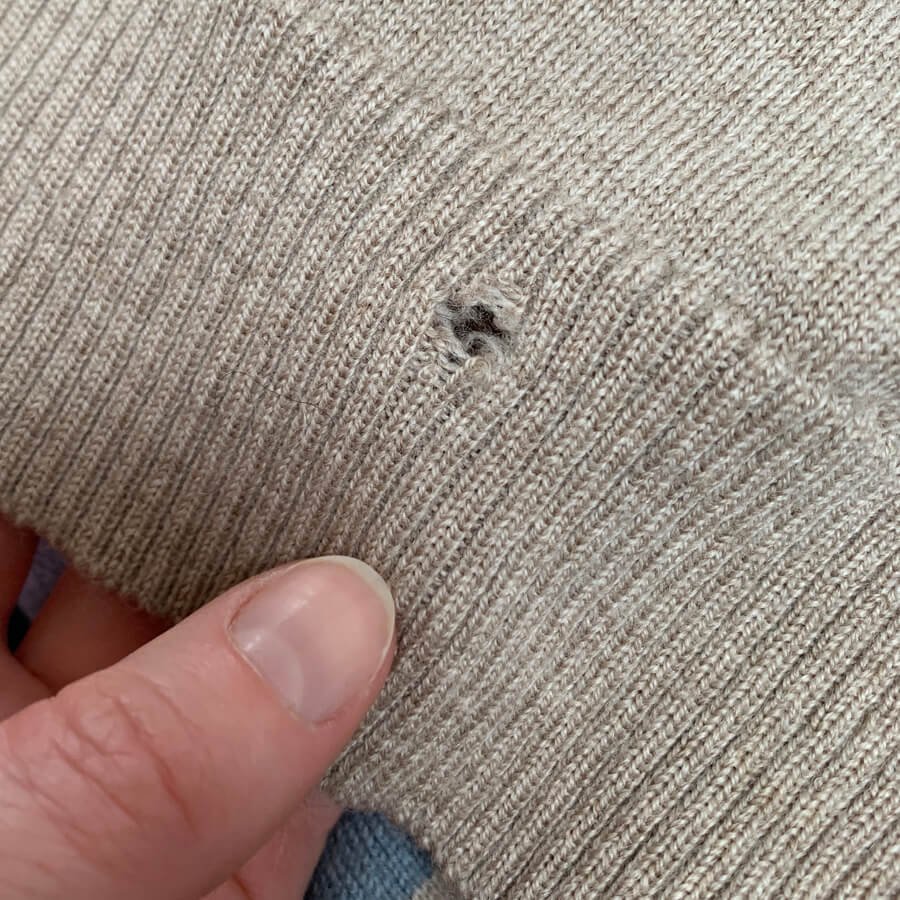Invisible vs Visible Mending
It might not come as a surprise to you if you’re already familiar with my work, that I’m a big fan of visible mending over invisible mending! I’ll share my reasons for this here, and what you’d need to have for invisible mending.
Visible mending is easier than invisible mending for several reasons:
1. Anyone can do it, including beginners
You don’t need in-depth knowledge of knitwear to get started. But if you’d like to have some knowledge, then my book is a great place to start, as it is useful to know what to look for, even for visible mending.
2. You don’t need to have matching yarn
Use yarns you already have, or find ones you think will look great with your garment. Not having to have the exact matching yarn is really liberating. You can always use contrasting yarns in terms of fibre and colour for visual effect.
3. People will assume you meant it to look like that!
Even if your mend isn’t perfect or doesn’t turn out quite as you might have liked, because you’ve made it colourful and creative, people will assume that’s how you wanted it to look. Wear it with pride and own it. And remember, most other people are only going to see it from a distance!
4. You have a much wider range of techniques and repair methods at your disposal.
You can create something that looks great using a variety of techniques, so you can choose to use the technique you feel most confident with, or mix and match as you want. I often combine darning, swiss darning and embroidery in my repairs, and it keeps the process exciting for me.
You could use patches, applique, crochet, knitting, darning, swiss darning, embroidery… whatever inspires you, whatever you can do and whatever you can think of!
5. You won’t end up with an invisible mend that isn’t quite invisible and looks like a stain.
In fact, I think it’s much more fun to find stains and turn them into features, as I have with this sweater (above). I haven’t covered every bit of the stains, but have used the circles to distract from the fabric underneath.
6. It’s more fun, so you’ll actually want to do it!
This is a crucial part of it for me. I don’t want my mending to feel like a chore, and by making it visible and creative, mending has become something I enjoy for it’s own sake. It’s an added bonus that it gives me back a much loved sweater so I can continue wearing it, saves money and reduces the use of new resources, and slows down the amount of textiles being thrown away.
Invisibly Mending Knitwear
Good invisible mending is exactly that- it’s invisible, and no one should be able to spot it.
Invisible mending is highly skilled and much harder to achieve than visible mending. When it comes to knitwear, for invisible mending you need exactly the same yarn as the garment. If you weren’t given any spare yarn when you bought it, or if you lost that bit of yarn, or your holes are large or you have a lot of them, this means you would have to take yarn from the garment to use for the repairs.
Getting yarn from the garment is going to mean undoing a bit (or potentially quite a lot) of the garment, unravelling some yarn, and repairing the bit you had to take apart. It’s a lot more work than visible mending, and requires good knowledge of knitwear and its construction.
For good invisible mending, swiss darning is a must have skill, and the only one you would need for repairing knitwear, as it mimics the knitted structure and allows you to reconstruct it.
Badly done invisible mending can look like a mark - it might just be that the area where the repair is looks thicker than the surrounding fabric, it might look slightly lumpy, or maybe the colour isn’t 100% right. In my opinion this isn’t worth it, and you’d be better to opt for something creative instead.
I have never been trained to do invisible mending (although I think I largely get the gist of it, and can do a mostly invisible mend). While I do enjoy the technical side of knit very much, I love the creative process of visible mending too much to want to worry about making my work invisible. I love making a statement, wearing something unique and taking about repairs if anyone comments on what I’m wearing.
For areas like underarms, I often opt for creating a more discreet repair. I often don’t have an exact colour match, but I use whatever I have that’s closest. I use discreet repairs for any areas I don’t want to draw attention to, and use whichever mending technique I think most appropriate- often darning if it’s an underarm hole.
This underarm repair is one of my discreet repairs. The first, lighter mend was done a while ago- I clearly used a slightly lighter yarn for some reason, even though i seem to have found a very good match for the second mend. I’ve used a little bit of darning and a little bit of swiss darning (although elongating stitches). It’s almost invisible, but not quite. If this was on the front of a sweater, I would probably prefer just to go for visible mending, rather than having a slight glitch people might notice. That’s personal preference of course!
I say enjoy the creative process, and embrace visible mending rather than worrying about invisibly mending your clothes. Show off your creativity, and start some conversations about keeping clothes for longer!











